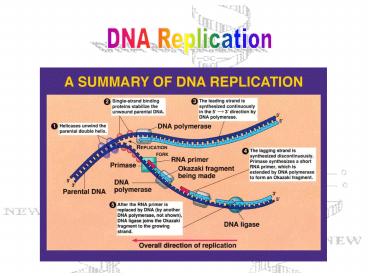http:www'johnkyrk'comDNAreplication'html - PowerPoint PPT Presentation
1 / 17
Title:
http:www'johnkyrk'comDNAreplication'html
Description:
... half of the DNA ladder serves as a template for making the other. ... swf::535::535::/sites/dl/free/0072437316/120076/micro04.swf::DNA Replicat ion Fork ... – PowerPoint PPT presentation
Number of Views:89
Avg rating:3.0/5.0
Title: http:www'johnkyrk'comDNAreplication'html
1
DNA Replication
- http//www.johnkyrk.com/DNAreplication.html
2
Nucleic Acids
- DNA and RNA are called nucleic acids.
- A nucleic acid is a huge polymer of either DNA or
RNA made up of monomers called nucleotides. - Each nucleotide has three parts
- Sugar Deoxyribose in DNA or Ribose in RNA
- Phosphate group
- Nitrogenous base
- DNAAdenine (A), Thymine (T), Guanine (G),
- Cytosine (C)
- RNAAdenine (A), Uracil (U), Guanine (G),
- Cytosine (C)
3
The 4 Nitrogenous Bases
- The four nitrogenous bases are adenine (A),
guanine (G), cytosine (C) and thymine (T)if DNA
or Uracil (U)if RNA.
adenine
thymine
Uracil
cytosine
guanine
4
Purines
- Adenine and guanine are the larger bases.
- These are called purines.
5
Pyrimidines
- Cytosine, thymine and uracil are the smaller
bases. - These are called pyrimidines.
6
PurinePyrimidine Pairs
- The purine adenine is always paired with the
pyrimidine thymine in DNA or the Pyrimidine
Uracil in RNA. - The purine guanine is always paired with the
pyrimidine cytosine. - DNA RNA
- A-T A-U
- G-C G-C
7
5 Carbon Sugar
- Deoxyribose and ribose are both 5-carbon sugars.
- We can number the carbons of the deoxyribose
sugar 1-5. - The nitrogenous base is bound to Carbon 1.
- The phosphate group is bound to Carbon 5.
8
Phosphodiester Bonds
- The Nucleotide monomers are linked together by
the phosphates. - These are called phosphodiester bonds
- One phosphate group joins the sugar of Carbon 3
of one nucleotide monomer to the carbon 5 of the
other.
9
Two Processes of DNA
- You need to understand two processes of DNA.
- Process 1 DNA Replication.
- Each new cell must contain the same DNA as the
original cell. - This is how the genetic material is conserved.
- Transcription and Translation
- This is the process of protein synthesis.
- This is how DNA functions in the cell.
10
DNA Replication
- Each chromosome is made of two strands of DNA.
- When a parent cell divides into two daughter
cells, during cell division, each new cell only
gets one strand of DNA from the parent cell. - However, every chromosome consists of two DNA
strands, not one. - Therefore, the single DNA strand passed from
parent to daughter cell must have a way to
replicate itself so that the new cells have two
DNA strands, not one.
11
DNA Replication
- Watson and Crick proposed that one half of the
DNA ladder serves as a template for making the
other. - In 1958 Matthew Meselson and Frank Stahl showed
that DNA does have a copying mechanism.
12
Conserved and Complementary
- When organisms reproduce, one strand of DNA is
passed unchanged to each of the two daughter
cells. - This is known as the conserved strand.
- The second has to be synthesized.
- This DNA strand is called the complementary
strand. - This is called semi-conservative replication
because each daughter cell has one old and one
newly synthesized DNA strand.
13
Anti-Parallel Strands
- The conserved strand is built in the 5 to 3
direction. - The complementary strand is anti-parallel and is
formed in the 3 to 5 direction. - Therefore each strand is a mirror image of the
other. - These strands are joined by the complementary
basesA with T and G with C.
14
DNA Helicase
- DNA replication begins when an enzyme called
helicase unwinds the two strands of DNA by
breaking the hydrogen bonds between the
nitrogenous bases.
15
The Leading Strand
- The conserved strand which is the 5 to 3 strand
is opened at the 3 end. - The replicating strand now copies the conserved
strand in the 5 to 3 direction. - DNA polymerase is an enzyme that adds the
nucleotides to make the copy. - This is called the leading strand and is
synthesized discontinuously.
16
The Lagging Strand
- The complementary strand, however, gets opened at
the 5 end. - This means that the replicating strand must copy
it in the 3 to 5 direction. - DNA polymerase can only add nucleotides in the 5
to 3 direction. - The lagging strand must be synthesized
discontinuously. - The discontinuous pieces are called Okazaki
fragments. - http//highered.mcgrawhill.com/olcweb/cgi/pluginpo
p.cgi?itswf535535/sites/dl/free/0072437316/
120076/micro04.swfDNA20Replication20Fork
17
Citations
- http//porpax.bio.miami.edu/cmallery/150/chemistr
y/sf3x14a.jpg - http//www.dnaftb.org/
- http//arbl.cvmbs.colostate.edu/hbooks/genetics/bi
otech/basics/nastruct.html - http//www.blc.arizona.edu/Molecular_Graphics/DNA_
Structure/DNA_Tutorial.HTML - http//www.bioteach.ubc.ca/TeachingResources/Molec
ularBiology/DNAReplication.swf - http//highered.mcgraw-hill.com/olcweb/cgi/pluginp
op.cgi?itswf535535/sites/dl/free/0072437316
/120076/micro04.swfDNA20Replication20Fork































